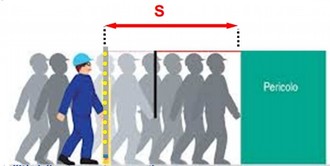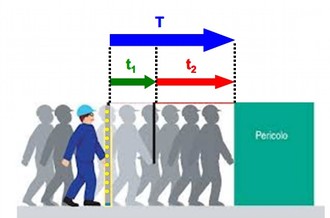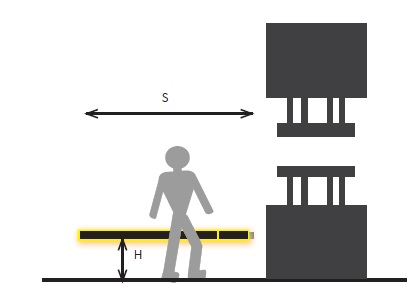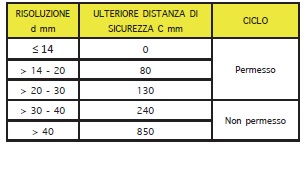Hesi Safety srl
Main menu
- About us
- Electronics
- Safety
- Characteristics
- Safety guide
-
Products
- HTB3 - 5mt - Espe Type 2 - Full Optional
- HTB5 - 5mt - Espe Type 4 - Full Optional
- HTBL3 - 17mt - Espe Type 2 - Full Optional
- HTBL5 - 17mt - Espe Type 4 - Full Optional
- HTBR3 - 5mt - Espe Type 2 - Basic
- HTBR5 - 5mt - Espe Type 4 - Basic
- HTBLR3 - 17mt - Espe Type 2 - Basic
- HTBLR5 - 17mt - Espe Type 4 - Basic
- HTBSM3 - 5mt - Espe Type 2 - Basic
- HTBSM5 - 5mt - Espe Type 4 - Basic
- HTBLM3 - 17mt - Espe Type 2 - Basic
- HTBLM5 - 17mt - Espe Type 4 - Basic
- HTBUM3 - 60mt - Espe Type 2 - Basic
- HTBUM5 - 60mt - Espe Type 4 - Basic
- HTBV5 - 5mt - Espe Type 4 - Full Optional
- HTB5 - LS01 - Pointing laser
- HTB6 - Laser
- Connecting Cables Barriers
- Power supply module AL01 - AL02
- Module safety relay AC02
- Relay single safety AC03
- Double Relay safety AC04
- Column with Mirror HTB5 - CSP
- Column for Light Curtains HTB5 - CPB
- Sensitive mats
- Sensitive edge mounted
- Edge Sensitive "DIY"
- Certification
- Contacts
Safety
EVALUATION OF THE SAFETY DISTANCE FOR A CORRECT INSTALLATION OF THE BARRIER
UNI EN ISO 13855:2010 Safety of machinery -
- Positioning of safeguards with respect to the approach speeds of parts of the human body
The safety distance "S" is the minimum distance between a photoelectric barrier and a hazard zone.
The safety distance prevents somebody from reaching the dangerous parts of the machine before its movement is stopped.
UNI EN ISO 13855/EN 999 specifies a formula to calculate this distance.
The synthetic formula described in that standard is:
S = K x T + C
Where:
S = minimum safety distance between the safeguard and the hazard point, expressed in mm.
K = approaching speed of the body or the limb, expressed in mm per second.
T = total time needed to halt the machine, composed by:
t1 response time of the safeguard device, in seconds
t2 time needed by the machine to halt, in seconds
C = additional distance in mm, that takes in consideration the possible approach of the body to the hazard zone before the safeguard device has been activated.


Evaluation of the safety distance for the vertical installation
S = safety distance in mm
H1 = the lowest beam must not be placed more than 300mm from ground
H2 = the highest beam must not be placed less than 900mm from ground
The following formula allows to calculate the safety distance for the vertical installation:
S = (2000 x T) + 8 x (d – 14)
where d is the resolution of the photoelectric barrier in mm
K = 2000 mm/s is the speed of the hand
The expression (8 x (d – 14)) can never be lower than 0.
The minimum safety distance S is therefore 100mm.
If the safety distance calculated with the previous formula exceeds 500mm,
the following formula can be used as an alternative:
S = (1600 x T) + 8 x (d -
where K = 1600mm/s is the speed of the body.
The minimum safety distance S is therefore 500mm.
Evaluation of safety distance for the horizontal installation
The standard formula: S = KxT + C, where
S = (1600 x T) + (1200 -
0,4 x H) C = (1200 – 0,4 x H), cannot be lower than 850mm
H = 15 x (d – 50) is the height of the safety field from the working plane, e.g. the floor.
The maximum allowed height "Hmax" of the security field is 1000mm, while the minimum allowed height "Hmin" of the security field is 0mm.
The required barrier resolution can be calculated using the inverse formula: d=H / (15 + 50)
When using a photoelectric barrier on the ground to guard an entrance, the photoelectric barrier must have a depth of at least 750mm, to avoid accidentally stepping on it.
The evaluated safety distance must be measured from the dangerous parts of the machine to the farthest (from the machine) beam of the photoelectric barrier.
Safety distance for old and new presses
New presses:
For the new presses with CE mark there are specific requirements described in EN 692 standards
Machine tools – Mechanical presses – Safety
and Machine tools – Safety – Hydraulic presses.
The same requirements are valid for the vertical installation on both presses and other machines, with the difference that C is defined as follow:

Old presses:
N.B. For old presses there are different regulations in each country.